
Aarhus Stadium is an association football stadium in Aarhus, Denmark which has been the home ground of Aarhus Gymnastikforening since the 1920s. With a current capacity of 19,433, it is the third largest football stadium of any football team in Denmark. It is part of the sports complex, known as Aarhus Sports Park, that is run by Ceres Park & Arena.

Aarhus City Hall is the city hall of Aarhus, Denmark. The decision to build a new city hall was taken during a city hall meeting in 1937. The new building was inaugurated 2 June 1941, designed by architects Arne Jacobsen and Erik Møller. On the first proposal, the plans did not include a tower but due to massive public pressure it was later added to the drawings along with the idea to clad the structure in marble. Hans Wegner was in charge of the furnishing - which is uniquely designed to fit the building -, and parts of the interior design.

The architecture of Denmark has its origins in the Viking period, richly revealed by archaeological finds. It became firmly established in the Middle Ages when first Romanesque, then Gothic churches and cathedrals sprang up throughout the country. It was during this period that, in a country with little access to stone, brick became the construction material of choice, not just for churches but also for fortifications and castles.

Arkitema Architects is a Danish architectural firm headquartered in Aarhus, with branch offices in Copenhagen, Malmö, Stockholm and Oslo. Arkitema Architects was founded in 1969 in Aarhus, and nowadays has about 400 employees with its main activity in Scandinavia.

Godsbanen is a cultural centre in central Aarhus, Denmark since 2012. The site and most of the buildings are a former goods station, known as "Aarhus Godsbanegård", which was in use from 1923 to 2000. It is located at the end of a broad sidetrack to the central railway yard of Aarhus. In December 2010, Realdania announced that the area would be gradually transformed into a modern city district, through a collaborative project with Aarhus Municipality. Apart from the new cultural centre of Godsbanen, there are plans to build several buildings and institutions along the former railway yard, including a new school of architecture.
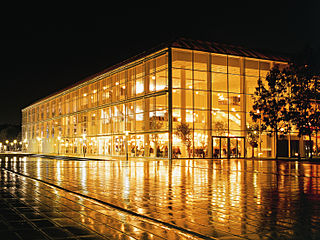
Musikhuset Aarhus is a large concert hall complex in Aarhus, Denmark. Located in the city centre, Musikhuset is Aarhus' main venue for music and with seating for more than 3,600 people in total, it is the largest concert hall in Scandinavia. Musikhuset Aarhus was designed by Kjær & Richter and built in 1979-1982, commissioned by Aarhus Municipality.
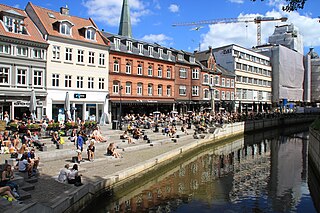
Indre By is a neighborhood in the city of Aarhus, Denmark. The neighborhood is bounded by Nørre Allé, Vester Allé and Sønder Allé and is composed of the neighborhood and historical centre of the Latin Quarter and the areas around the Central Station and the City Hall Park. The neighborhood is one of the three main neighborhoods in the district of Aarhus C, along with Frederiksbjerg and Vesterbro.
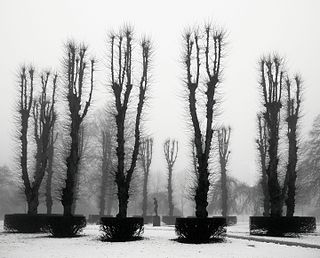
Rådhusparken is a public park in central Aarhus, Denmark. The park is situated by the City Hall in the Indre By neighborhood of Midtbyen, between the streets Frederiks Allé to the west and Park Allé to the east. The park lies within a scenic semi-circle of some of the more important cultural and political institutions in the city; the Concert Hall, the ARoS Art Museum, Vester Allés Kaserne and the city hall. The City Hall Park was listed along with the adjacent city hall on 10 March 1995.
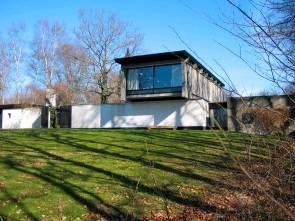
Højen 13 is a villa and listed building in Aarhus, Denmark. The villa was built in 1958 and was listed in the Danish registry of protected buildings and places by the Danish Heritage Agency on 11 January 2008. The house was built by the architect Knud Friis as his home and study on a hill overlooking Brabrand Lake in the Brabrand suburb.
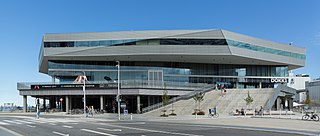
Dokk1 or Dokken is a government building, public library and culture center in Aarhus, Denmark. It is situated on Hack Kampmanns Plads in the city center by the waterfront next to the Custom House. Dokk1 is part of the much larger development project Urban Mediaspace Aarhus, jointly financed by Aarhus Municipality and Realdania for 2.1 billion DKK. It is designed by Schmidt Hammer Lassen Architects and Kristine Jensen, with construction managed by NCC AB. Construction broke ground 8 June 2011 and the building was inaugurated four years later on 20 June 2015.

The Danish National Exhibition of 1909 or The National Exhibition in Aarhus 1909 was an industry, crafts and culture exhibition held in Aarhus, Denmark in 1909 from 18 May to 3 October. The exhibition displayed some 1850 individual works by architects, artists, craftsmen and businesses and attracted 650.000 visitors. The project was a large undertaking for the city with long-lasting effects on cultural institutions and short-term economic problems. The exhibition fairgrounds was named The white City based on the architectural expression chosen by the leading architect Anton Rosen.

Hotel Royal is a historic hotel in the heart of Aarhus, Denmark, in the central Indre By neighborhood. It overlooks Aarhus Cathedral and the large Store Torv square. The hotel is among the highest ranked hotels in Denmark with a history as the most prestigious in the city.

Catholic Church of Our Lady is a church in Aarhus, Denmark. The church is situated in the central Indre By neighbourhood on the pedestrian street Ryesgade, close to the Central Station and City Hall. It is a catholic church under the Roman Catholic Diocese of Copenhagen; built between 1877 and 1880 by designs of the German architect Franz Schmitz and later renovated by the architect Carl R. Frederiksen. The church has seating for 500 people.

The Concert Hall Park is a public park in central Aarhus, Denmark. The park is laid out in front of the Aarhus Concert Hall main entrances in the Indre By neighborhood of the inner city. It is bordered by the street Frederiks Allé to the east, Thomas Jensen's Allé to the south and Vester Allé to the north, behind the historic buildings of the former Vester Allés Barracks. The park is named after the Aarhus Concert Hall which is situated prominently immediately west of the park. The Concert Hall Park forms a center-point between some of the most prominent buildings in the city, the ARoS Aarhus Art Museum, Vester Allé Barracks, the concert halls, and Aarhus City Hall in view behind the City Hall Park across Frederiks Allé. The Concert Hall Park was designed by the landscape architect Sven Hansen as a parterre garden, and it was established in the 1980s.

The architecture of Aarhus comprises numerous architectural styles and works from the Middle Ages to present-day. Aarhus has a well-preserved medieval city center with the oldest dwellings dating back to the mid-1500s and some ecclesiastical structures such as St. Clemen's Cathedral and numerous smaller churches that can be traced back to the 1100s. The industrialization of the 19th and 20th centuries left distinctive industrial structures, important National romantic works and some of the best examples of Functionalist architecture in the country. The history of the city as a Viking fort is evidenced in the street layout of the Latin Quarter, the wider Indre By neighborhood testifies to its later role as a Market town and center of commerce while the Frederiksbjerg, Trøjborg and Marselisborg districts showcase the first cohesive urban planning efforts of the early 20th century.
Knud Friis was a Danish Modernistic architect who worked extensively in Denmark and founded Friis & Moltke.

Friis & Moltke is a Danish architectural practice headquartered in Aarhus with branch offices in Copenhagen and Aalborg. Friis & Moltke has about 50 employees and is mainly active in the Scandinavian market. The firm was founded in 1955 by the architects Knud Friis and Elmar Moltke Nielsen who met while working at C. F. Møller Architects in Aarhus. Today the company has 6 partners and 1 associated partner responsible for the department of furniture design.
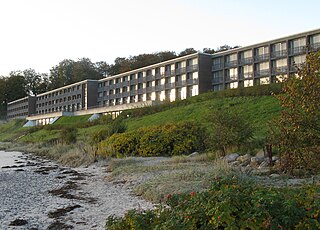
Hotel Marselis or Marselis Hotel - Aarhus is a hotel in Aarhus, Denmark. It is located in the Marselisborg Forests, in the Højbjerg district. It overlooks the Bay of Aarhus from a prominent position on the coast. The hotel is owned by the company Helnan Hotels which also operates a hotel in Aalborg. The hotel includes 163 rooms and beyond common amenities also feature conference and meeting rooms. Marselis Hotel is a four star hotel (2016) and is member of the Danish hotel organization Horesta.
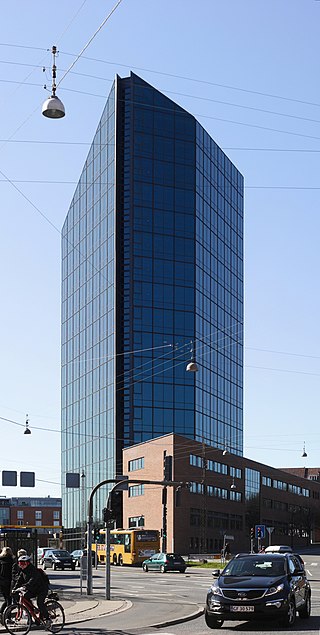
Prismet is an office building in Aarhus, Denmark. It is one of the tallest buildings in the city and it was the first building more than 50 meters tall built in Aarhus city center since the early 1970s. Prismet was built by the Danish investment group PFA Byg A/S between 1999 and 2002. The contractor was H. Hoffmann & Sønner A/S, the engineer Birch & Krogboe A/S and the architect company Friis & Moltke. The landscape architect firm Schønherr designed the outdoors areas, including a small park. The project covers 17800 m2.

Lisbjerg Power Station also known as Affaldscenter and Biomassefyret Kraftvarmeværk A/S is a combined heat and power plant in Lisbjerg, Denmark. The power plant is composed of two units; a waste-to-power incinerator and a biomass plant. The official address is Ølstedvej 20-36, 8200 Aarhus N and it is managed by AffaldVarme Aarhus as a part of the Teknik og Miljø magistrate of Aarhus Municipality. The biomass facility supplies district heating to 20% of homes in Aarhus Municipality and it is one of the largest of its kind in Denmark.
























